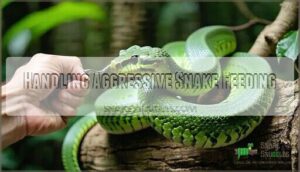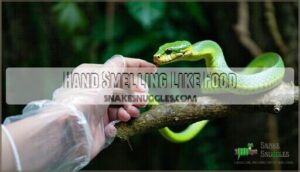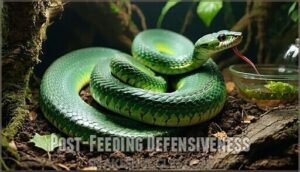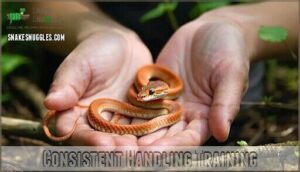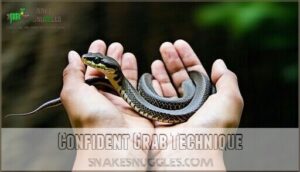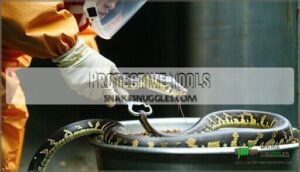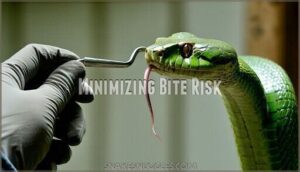This site is supported by our readers. We may earn a commission, at no cost to you, if you purchase through links.
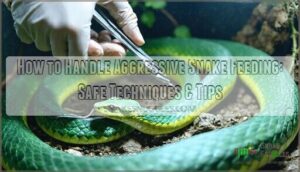
The key to handling aggressive snake feeding lies in staying calm and using the right approach.
Move slowly and deliberately – sudden movements trigger their defensive instincts.
Use proper tools like feeding tongs, snake hooks, and protective gloves to keep a safe distance.
Feed on a consistent schedule with appropriately-sized frozen-thawed prey to reduce stress.
Never handle with bare hands when your snake’s in feeding mode, as they might mistake you for dinner.
Smart preparation and the right techniques can transform even the most defensive snake into a manageable feeding partner.
Table Of Contents
- Key Takeaways
- Aggressive Snake Feeding
- Handling Aggressive Snake Feeding
- Safe Feeding Techniques
- Reducing Feeding Aggression
- Snake Handling and Training
- Minimizing Bite Risk
- Frequently Asked Questions (FAQs)
- How to deal with aggressive pet snakes?
- Why is my snake aggressive after feeding?
- Why is my snake aggressive?
- How to calm down a snake?
- How do you retrain a snake to eat?
- How to handle a snake with Cage aggression?
- How to force feed a snake that won’t eat?
- How to calm down an angry snake?
- How to pick up an aggressive corn snake?
- Can I feed multiple snakes together safely?
- Conclusion
Key Takeaways
- Use proper tools like long feeding tongs (12-24 inches) and protective gloves to maintain a safe distance from your snake’s striking range during meals
- Establish consistent feeding schedules with appropriately-sized frozen-thawed prey to reduce stress and prevent your snake from confusing routine handling with feeding time
- Move slowly and deliberately around your snake’s enclosure—sudden movements trigger their defensive instincts and increase aggressive feeding responses
- Wait 48 hours after feeding before handling your snake, as they’re naturally more defensive during digestion and vulnerable to regurgitation if disturbed
Aggressive Snake Feeding
When your snake transforms into a striking machine at feeding time, you’re witnessing natural defensive behavior rather than true aggression.
Environmental stress and feeding triggers can turn even docile snakes into defensive biters who mistake your hand for their next meal.
Snake Defensive Behaviors
During defensive displays, your snake isn’t being "aggressive"—they’re protecting themselves from perceived threats.
Understanding snake feeding aggression starts with recognizing these defensive triggers and species differences that influence behavior. Reptiles will often display anti-predatory behaviors when they don’t feel secure.
- Shedding anxiety makes snakes nearly blind and extra defensive
- Territoriality kicks in when they feel their space is invaded
- Mimicry behavior like bull snakes rattling their tails to seem dangerous
- Feeding response confusion turns routine care into perceived hunting time
Environmental Factors
Your snake’s home environment directly impacts snake feeding behavior and aggression levels.
Poor enclosure size, inadequate hiding spots, incorrect temperature gradient, or improper humidity levels create stress that amplifies snake feeding aggression.
Traffic noise and high-activity areas worsen aggressive snake feeding responses.
Environmental conditions like overcrowding or insufficient enrichment trigger defensive behaviors during feeding time, making your snake more reactive and prone to striking.
Handling Aggressive Snake Feeding
Understanding aggressive snake feeding starts with recognizing your reptile’s natural hunting instincts. When you approach during feeding time, your snake’s brain switches into predator mode, making even docile species surprisingly reactive.
Managing this behavior requires strategic planning. Prey Scent Control becomes your first line of defense—wash hands thoroughly after handling any food items. Environmental Stressors like improper temperatures or inadequate hiding spots amplify feeding aggression, so check these factors regularly.
Post-Defecation Feeding timing matters too, as hungry snakes become more food-motivated after eliminating waste. Recognizing defensive snake posturing can also help prevent escalation.
Here’s your action plan for safer feeding sessions:
- Implement tap training benefits by gently nudging your snake with a hook before opening the enclosure
- Use designated feeding bins to separate feeding territory from regular handling space
- Monitor environmental conditions to reduce stress-induced feeding responses
Snake feeding techniques that prioritize reptile feeding safety help transform chaotic mealtimes into controlled interactions. Your snake feeding behavior understanding directly impacts both your safety and your pet’s well-being during these high-energy moments.
Safe Feeding Techniques
When your snake strikes at anything that moves near its enclosure, you’re dealing with an automatic feeding response that can turn feeding time into a dangerous guessing game.
Understanding the specific triggers behind aggressive feeding behavior helps you create safer routines that protect both you and your snake from unnecessary stress and potential injury.
Automatic Feeding Response
Your snake’s brain switches to hunt mode when it detects food cues.
This automatic feeding response creates a conditioned response where opening the enclosure triggers anticipatory behavior.
The learned association between cage access and meals forms through habit formation.
Once this stimulus control develops, your snake strikes at movement automatically, mistaking your hand for prey during feeding time.
Snakes use a specialized sensory system to detect prey, utilizing a unique method to locate their targets, which can lead to automatic feeding responses.
Hand Smelling Like Food
Your hands can betray you during snake feeding.
Your scent can trigger strikes even when you’re not feeding your snake.
Scent transfer from prey triggers automatic feeding response even when you’re not offering food.
Wash hands thoroughly before and after handling snake food to avoid cross-contamination.
Consider glove usage for safe snake feeding sessions.
Snakes rely heavily on scent recognition, so even trace odors can activate their feeding response and lead to mistaken strikes during routine handling.
Feeding Inside Enclosure
Keeping your snake in its home enclosure during feeding offers significant Enclosure Feeding Benefits through Stress Reduction.
This approach minimizes handling stress and prevents aggressive reptile behavior triggered by territorial displacement.
Handler Safety improves since you’re not wrestling with a defensive snake between containers.
Snake feeding strategies work better when snakes feel secure in familiar surroundings.
However, Territorial Behavior may intensify as your snake associates its space with food, requiring careful snake aggression management and Observation Importance for future feeding response patterns.
Post-Feeding Defensiveness
After feeding, your snake might seem more defensive due to hormone release and vulnerability instincts.
During the digestion period, snakes feel exposed and protective.
Wait 48 hours before handling to avoid regurgitation risk.
Hunger cues trigger aggressive behavior initially, but this settles as digestion begins, helping you understand snake feeding habits to manage snake aggression control effectively.
Reducing Feeding Aggression
You can reduce feeding aggression through consistent routines and proper equipment that help your snake distinguish between feeding time and handling time.
Establishing clear feeding protocols prevents confusion and creates safer interactions for both you and your pet.
Consistent Feeding Schedules
When you establish consistent feeding schedules, you’re creating predictable hunger patterns that substantially reduce stress and snake aggression.
Regular feeding intervals help maintain proper digestive health while minimizing behavioral impacts from unpredictable meals.
Your snake’s feeding habits become more manageable, and routine benefits extend beyond just nutrition—consistent feeding frequency actually calms defensive responses during feeding time, which can reduce stress and aggression.
Prey Item Size
Getting your prey sizing right cuts down snake aggression dramatically.
When food’s too big, you’re setting up your snake for regurgitation risk and impaction prevention becomes vital.
Proper snake diet matching nutritional needs keeps growth rates steady while avoiding overfeeding dangers.
Here’s your sizing checklist:
- Measure the girth – Choose prey 1-1.5 times your snake’s widest body section
- Weight matters – Keep prey under 10-15% of juvenile body weight for safety
- Watch for refusal – If your snake won’t eat, the food might be oversized
Snake hunger drives feeding problems when portions don’t match body size.
Too-large meals trigger defensive behavior because digestion becomes stressful.
Your snake food size directly impacts how aggressive they get during feeding time.
Frozen-Thawed Prey
Frozen-thawed prey offers significant safety advantages over live prey when dealing with snake aggression and reptile feeding problems.
You’ll eliminate the risk of prey animals injuring your snake during feeding frenzies. Proper thawing methods maintain nutritional value while reducing prey smell that triggers excessive snake aggression.
This controlled approach helps manage snake picky eater behaviors effectively. Using stainless steel tweezers can also help avoid scent association during feeding, which is a key factor in reducing snake aggression and promoting a healthy feeding environment with frozen-thawed prey.
Long Feeding Tongs
Distance matters when you’re feeding aggressive snakes. Long feeding tongs keep your hands safely away from striking range while delivering prey.
The right equipment transforms a risky situation into a controlled feeding experience. You can find various feeding tools for this purpose.
- Tongs Length: Use 12-24 inch tongs for maximum safety distance from aggressive snakes during feeding sessions.
- Tongs Material: Choose stainless steel feeding tongs for durability, easy sanitization, and reliable grip on prey items.
- Tongs Maintenance: Clean tongs after each use and inspect regularly for damage that could compromise snake handling equipment safety.
Snake Handling and Training
Proper handling training transforms even the most defensive snakes into manageable pets through consistent daily practice.
You’ll need the right techniques and protective tools to safely work with food-aggressive snakes while building their confidence over time, using consistent daily practice to achieve this goal.
Consistent Handling Training
How can consistent handling training transform your defensive snake into a calm companion? Regular, gentle sessions build trust and reduce food-related aggression through gradual introduction and positive reinforcement.
Early socialization prevents automatic feeding responses that trigger snake aggression. This is a crucial step in developing a calm and trusting relationship with your snake.
| Training Aspect | Frequency |
|---|---|
| Handling sessions | 15 minutes, twice daily |
| Early socialization | Start with baby snakes |
| Building trust period | Several weeks minimum |
| Snake feeding intervals | Separate from handling time |
Consistent snake handling training rewires defensive responses. Your snake learns that enclosure opening doesn’t always mean mealtime, reducing strikes during routine care. Through regular sessions and proper training, you can create a safe and trusting environment for both you and your snake.
Confident Grab Technique
Firm contact breaks the ice between you and aggressive snakes.
The confident grab technique uses deliberate, steady movements to establish trust while reducing stress through consistent contact. This method helps desensitize defensive snakes to human touch.
- Reducing Stress: Apply steady pressure without hesitation to prevent startling the snake
- Handling Frequency: Practice this technique during regular non-feeding sessions for gradual introduction
- Building Trust: Maintain calm, confident movements to show you’re not a threat
- Positive Reinforcement: Reward calm behavior with gentle handling to reduce food-related aggression
Protective Tools
Essential snake handling protective gear creates a safety barrier between you and defensive snakes.
Snake gloves made from leather or Kevlar materials protect against bites, while hooks with ergonomic design allow distance control.
Tongs length of 12-24 inches maintains safe spacing during feeding.
Snake bags provide secure transport, and protective suits offer full-body coverage for aggressive species.
Consider specialized handling equipment for enhanced safety and to ensure you have the right handling equipment.
Avoiding Handling During Shedding
During snake shedding, your pet experiences vision impairment and skin sensitivity that dramatically increases snake aggression.
Avoid all snake handling during this vulnerable period, as shedding stress makes even docile snakes defensive.
Their cloudy eyes can’t distinguish between threats and routine care.
Wait until post-shed handling becomes safe—typically 48 hours after the old skin completely comes off—before resuming normal snake feeding routines.
Maintaining proper humidity aids shedding is crucial.
Minimizing Bite Risk
Even the most experienced snake handlers can face bite risks when dealing with aggressive feeders, but proper equipment makes all the difference.
You’ll need specific tools and techniques to protect yourself while maintaining your snake’s feeding routine safely.
Snake Hooks and Gloves
Quality snake hooks and snake handling gloves form your first line of defense against food-related aggression.
Choose hooks with appropriate Hook Material like stainless steel for durability and easy Cleaning Methods. Proper Sizing guarantees control without startling your snake.
Glove Thickness should balance protection with dexterity. Consider specialized handling options for enhanced safety.
Store equipment properly through Safe Storage practices to maintain effectiveness and prevent snake aggression during handling safety procedures.
Stainless Steel Feeding Tongs
Throughout your feeding routine, stainless steel feeding tongs prove invaluable for maintaining safe distance from aggressive snakes.
These durable tools resist damage from repeated sanitizing and won’t crack under pressure.
Choose 12-24 inch tongs for ideal reach – tong size matters when dealing with food-related aggression.
For most snakes, a 40-inch tong length offers a good balance of control and safety.
Ergonomic tong design reduces hand fatigue during extended sessions, while proper tong storage solutions keep them accessible yet secure between uses.
Reptile Gloves
Beyond the surface of basic protection, reptile gloves offer multiple layers of defense against aggressive snakes and food-related aggression.
Quality glove materials like leather or Kevlar provide essential bite protection while maintaining glove dexterity for precise handling.
Consider these key factors:
- Glove Materials – Leather offers flexibility, while Kevlar provides maximum puncture resistance
- Cleaning Gloves – Regular sanitization prevents bacterial buildup and maintains grip
- Glove Longevity – Quality materials withstand repeated use and cleaning cycles
Proper snake handling gear transforms potentially dangerous encounters into manageable situations.
Alcohol-Based Sanitizer
While other protective gear shields your hands, alcohol-based sanitizer serves as an emergency bite grip release method.
The sharp smell and taste can force aggressive snakes to let go during feeding incidents.
However, sanitizer poses health risks to snakes through skin irritation and potential toxicity.
Use sparingly only in emergencies, then rinse immediately with water.
Frequently Asked Questions (FAQs)
How to deal with aggressive pet snakes?
Imagine your ball python turning into a striking machine every time you open its enclosure.
Use long feeding tongs, tap-train with a hook, handle consistently outside feeding times, and make certain proper temperature and hiding spots to reduce defensive behaviors.
Ensure you provide the right environment by making certain proper temperature and hiding spots are available to reduce defensive behaviors.
Why is my snake aggressive after feeding?
Your snake’s post-feeding aggression stems from vulnerability instincts and hormone release.
After eating, they’re defensive because they can’t escape quickly.
Hunger hormones and territorial behavior also contribute to this natural protective response.
Why is my snake aggressive?
Picture coiled tension ready to strike—your snake’s aggression isn’t personal malice but defensive behavior.
Fear, stress, illness, improper handling, territorial instincts, or environmental issues like wrong temperatures trigger this protective response naturally, which is a result of the snake’s aggression.
How to calm down a snake?
Move slowly and confidently while avoiding sudden movements. Use gentle handling techniques, maintain proper enclosure conditions, and establish consistent routines to reduce your snake’s stress levels effectively.
How do you retrain a snake to eat?
Gradually reintroduce food by offering smaller prey items on consistent schedules. Use feeding tongs to maintain distance, and reduce handling frequency until the snake accepts meals regularly again.
How to handle a snake with Cage aggression?
Before telegraphs carried news, snake handlers knew that cage aggression stems from territorial defense and feeding confusion.
Use hook training to gently signal non-feeding interactions, consistently handle outside feeding times, and make certain proper enclosure conditions reduce stress-driven territorial behavior.
How to force feed a snake that won’t eat?
Force-feeding snakes is dangerous and shouldn’t be attempted by owners.
Instead, address underlying issues: check temperatures, reduce stress, try different prey types.
And consult an exotic veterinarian for assist-feeding techniques if medically necessary.
How to calm down an angry snake?
Like soothing a storm-tossed ship, you’ll need patience and calm movements.
Keep your distance, avoid sudden gestures, and wait for defensive posturing to subside.
Use gentle hook training and consistent handling to build trust over time.
How to pick up an aggressive corn snake?
Use a snake hook to gently lift the corn snake’s midsection while supporting its body weight.
Move slowly and confidently – sudden movements trigger defensive strikes.
Wait until it’s calm before attempting pickup, this is a complete concept to ensure safety.
Can I feed multiple snakes together safely?
No, you shouldn’t feed multiple snakes together.
Snakes become territorial and food-aggressive during feeding, leading to competition, stress, and potential injury.
They may strike each other or engage in food fights, causing serious harm.
Conclusion
Like a nervous chef approaching a hot stove, many snake owners freeze up when their pet gets defensive during meals.
Success with how to handle aggressive snake feeding comes down to preparation and patience.
You’ll transform feeding time from a stressful ordeal into a routine task by using proper tools, maintaining consistent schedules, and respecting your snake’s space.
Remember, defensive behavior isn’t personal—it’s instinct.
With practice and the right techniques, you’ll confidently manage even the most food-aggressive serpent.
- https://reptifiles.com/snake-bite-strike-constricting/
- https://www.reddit.com/r/ballpython/comments/jcvp80/strong_feeding_response_biting_tips/
- https://enviroliteracy.org/animals/how-do-you-deal-with-an-aggressive-snake/
- https://showmereptileshow.com/resources/exploring-the-world-of-reptile-handling-tools
- https://www.youtube.com/watch?v=m5rYTOi4cC4

